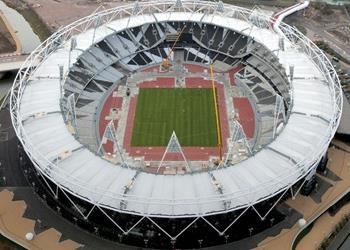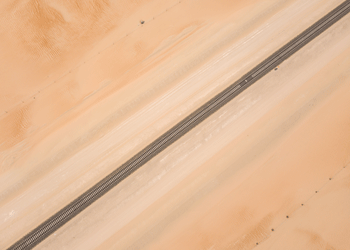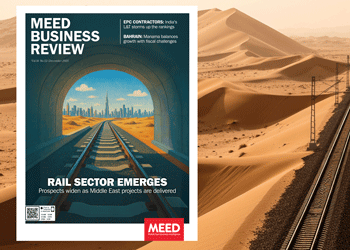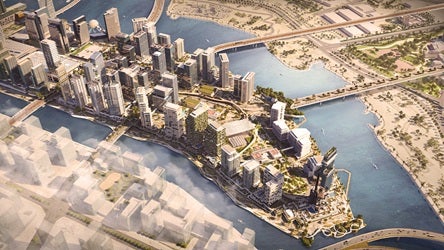Hospital boost for Jordan construction
5 June 2023
 This package on Jordan's construction sector also includes:
This package on Jordan's construction sector also includes:
> Egis selected for Jordan hospital project
> Jordan's largest construction project to move onsite
> Hill wins work on Saudi-backed hospital project in Jordan
> PIF to invest $24bn in six Mena countries
Jordan’s construction sector will get a major boost this year as the country’s largest project prepares to move onsite over the summer after the first phase of its masterplan has been finalised.
The $400m hospital project is being developed by the Saudi Jordanian Fund for Medical and Educational Investments Company (SJFMEI) on a build-operate-transfer (BOT) basis.
For the hospital project, SJFMEI appointed US-based Hill International in partnership with the local sub-consultant Dar al-Omran to provide project construction management services last year. The project team is now preparing to tender construction contracts.
“We have completed the first phase of the masterplan,” Said Mneimne, senior vice-president of Hill International, told MEED in an interview.
“This summer, we will appoint a contractor for the enabling works. We will then appoint a contractor for the foundations and the structure,” he added.
The scale of the project is a challenge for Jordan’s construction sector, and an international engineering, procurement and construction (EPC) contractor may be needed to deliver the project.
“We have not yet decided what the contracting strategy will be,” Mneimne said.
The project involves the construction of a university hospital with 330 beds, 72 outpatient clinics, a children’s hospital, and a medical school with a total capacity of 600 students and a projected annual intake of 100 students.
The project also includes five medical centres of excellence focused on disciplines such as cardiology, oncology, neurology, gastroenterology and orthopaedics. There will also be four scientific research centres in genomics and precision medicine, stem cells and regenerative medicine, health systems and public health, and bioinformatics.
The built-up area is estimated at 110,000 square metres. It will be located on the airport road, near the Ghamadan area on the outskirts of Amman.
A joint venture of Lebanon’s Dar al-Handasah (Shair & Partners) and Perkins & Will was appointed for the engineering design and supervision services.
SJFMEI is a wholly owned subsidiary of the Saudi Jordanian Investment Fund (SJIF). Saudi Arabia’s Public Investment Fund (PIF) owns 95 per cent of the fund, while Jordanian banks hold the remaining 5 per cent.
Ownership of the project will be transferred to the Jordanian government after the end of the investment period.
The hospital is the largest active standalone project in Jordan, according to regional projects tracker MEED Projects. The second-largest project is the estimated $228m King Hussein Bridge Terminal and Freight Yard project, which is at the prequalification stage.
Disappointing decade
Major projects are needed after a disappointing decade for Jordan’s construction sector.
Data from MEED Projects shows a fluctuating trend in the value of construction and transport contracts awarded in Jordan over the past 10 years.
In 2013, the total value stood at $1.429bn. A sharp rise in 2014 to $2.475bn marked the peak of contract awards during the period.
A steep fall was witnessed in the subsequent years, with the total value plunging to just $662m in 2015, a dramatic decrease of nearly 73 per cent from the previous year. This downward trajectory continued, with the value plummeting further to a record low of $79m in 2020 amid the global economic disruption caused by the Covid-19 pandemic.
A closer look at the data indicates periods of minor recovery, notably in 2017, when contract awards rose to $866m, following a particularly poor performance in 2016 at just $159m.
Despite these rebounds, the overall trend illustrates a declining construction and transport sector in Jordan, with the years 2021 and 2022 recording values of $32m and $86m, respectively, a stark contrast to the highs of 2013 and 2014.
The fluctuating values in contract awards reveal the industry’s volatility over the past decade, linked to regional instability, economic downturns and global disruptions including the Covid-19 pandemic.

Exclusive from Meed
-
 Riyadh prepares Qiddiya National Athletics Stadium tender
Riyadh prepares Qiddiya National Athletics Stadium tender9 December 2025
-
 Saudi Arabia and Qatar sign high-speed rail link agreement
Saudi Arabia and Qatar sign high-speed rail link agreement9 December 2025
-
 Oman green hydrogen projects cancelled
Oman green hydrogen projects cancelled8 December 2025
-
 Regional rail industry emerges
Regional rail industry emerges8 December 2025
-
 Aldar and Mubadala plan $16bn financial district expansion
Aldar and Mubadala plan $16bn financial district expansion8 December 2025
All of this is only 1% of what MEED.com has to offer
Subscribe now and unlock all the 153,671 articles on MEED.com
- All the latest news, data, and market intelligence across MENA at your fingerprints
- First-hand updates and inside information on projects, clients and competitors that matter to you
- 20 years' archive of information, data, and news for you to access at your convenience
- Strategize to succeed and minimise risks with timely analysis of current and future market trends

Related Articles
-
 Riyadh prepares Qiddiya National Athletics Stadium tender
Riyadh prepares Qiddiya National Athletics Stadium tender9 December 2025

Saudi gigaproject developer Qiddiya Investment Company (QIC) is expected to float a tender soon for the construction of the estimated SR7bn ($1.8bn) National Athletics Stadium at its Qiddiya entertainment city development.
MEED understands that the prequalification process has reached an advanced stage and the tender for the main contract is likely to be issued within a few weeks.
The multipurpose stadium will cover an area of approximately 182,000 square metres and its design is inspired by the London Olympic Stadium.
In September, MEED exclusively reported that QIC had begun the procurement process for the kingdom’s next major sporting destination, having received expressions of interest from contractors for the project.
UK-based HOK is the project’s lead design consultant. It is supported by Canadian engineering firm WSP and Germany’s Schlaich Bergermann Partner.
UK-headquartered WT Partnership is serving as the project’s cost consultant.
The stadium will be located within the Qiddiya Sports Park cluster and is expected to be completed by 2030.
In December 2020, Saudi Arabia was selected to host the 2034 Asian Games. The 22nd edition of the event will be held in Riyadh from 29 November to 14 December 2034.
Saudi Arabia is also set to host the Asian Winter Games in 2029. In October 2022, the Trojena development at Neom, in the northwest of the country, was selected to host the ninth edition of the event.
The National Athletics Stadium is one of several major projects within the wider Qiddiya development. Others include an e-games arena, Prince Mohammed Bin Salman Stadium, a performing arts centre, a motorsports track, Dragon Ball and Six Flags theme parks and Aquarabia waterpark.
The project is a key part of Riyadh’s strategy to boost leisure tourism in the kingdom. According to UK analytics firm GlobalData, leisure tourism in Saudi Arabia has experienced significant growth in recent years.
Domestic leisure tourism trips increased to 33.76 million in 2023, up from 16.74 million in 2018. International tourist arrivals for recreational purposes increased by 600% from 2018 to 2023.
Image: Buro Happold
 READ THE DECEMBER 2025 MEED BUSINESS REVIEW – click here to view PDF
READ THE DECEMBER 2025 MEED BUSINESS REVIEW – click here to view PDFProspects widen as Middle East rail projects are delivered; India’s L&T storms up MEED’s EPC contractor ranking; Manama balances growth with fiscal challenges
Distributed to senior decision-makers in the region and around the world, the December 2025 edition of MEED Business Review includes:
> AGENDA 1: Regional rail construction surges ahead> INDUSTRY REPORT 1: Larsen & Toubro climbs EPC contractor ranking> INDUSTRY REPORT 2: Chinese firms expand oil and gas presence> CONSTRUCTION: Aramco Stadium races towards completion> RENEWABLES: UAE moves ahead with $6bn solar and storage project> INTERVIEW: Engie pivots towards renewables projects> BAHRAIN MARKET FOCUS: Manama pursues reform amid strainTo see previous issues of MEED Business Review, please click herehttps://image.digitalinsightresearch.in/uploads/NewsArticle/15217660/main.jpg -
 Saudi Arabia and Qatar sign high-speed rail link agreement
Saudi Arabia and Qatar sign high-speed rail link agreement9 December 2025
Saudi Arabia and Qatar have signed an agreement to build a proposed high-speed rail line connecting Riyadh and Doha.
The agreement was signed by Saudi Arabia's Transport & Logistics Services Minister, Saleh Al-Jasser, and Qatar's Transport Minister, Sheikh Mohammed Bin Abdulla Bin Mohammed Al-Thani.
The high-speed railway line will cover 785 kilometres (km) and will pass through Hofuf and Dammam, while also linking King Salman International airport and Hamad International airport.
The train's speed will exceed 300 kilometres an hour, reducing travel time between the two capitals to about two hours.
The project is slated for completion in six years. The project is expected to serve over 10 million passengers annually and create more than 30,000 direct and indirect jobs.
Riyadh and Doha relaunched a proposed rail link connecting the two countries in 2022, after agreeing to set a date to begin studying the connection.
In July of that year, France’s Systra was selected to conduct a feasibility study on the proposed scheme, as MEED reported.
A rail link connecting Saudi Arabia and Qatar was planned before the diplomatic dispute that froze relations between Riyadh and Doha from 2017 until the Al-Ula Declaration was signed in January 2021.
In 2016, Qatar Railways Company (Qatar Rail) was planning to tender the design-and-build contract for the construction of regional railways in Qatar, including the link connecting to the Saudi border.
 READ THE DECEMBER 2025 MEED BUSINESS REVIEW – click here to view PDF
READ THE DECEMBER 2025 MEED BUSINESS REVIEW – click here to view PDFProspects widen as Middle East rail projects are delivered; India’s L&T storms up MEED’s EPC contractor ranking; Manama balances growth with fiscal challenges
Distributed to senior decision-makers in the region and around the world, the December 2025 edition of MEED Business Review includes:
> AGENDA 1: Regional rail construction surges ahead> INDUSTRY REPORT 1: Larsen & Toubro climbs EPC contractor ranking> INDUSTRY REPORT 2: Chinese firms expand oil and gas presence> CONSTRUCTION: Aramco Stadium races towards completion> RENEWABLES: UAE moves ahead with $6bn solar and storage project> INTERVIEW: Engie pivots towards renewables projects> BAHRAIN MARKET FOCUS: Manama pursues reform amid strainTo see previous issues of MEED Business Review, please click herehttps://image.digitalinsightresearch.in/uploads/NewsArticle/15217463/main.gif -
 Oman green hydrogen projects cancelled
Oman green hydrogen projects cancelled8 December 2025
Hydrogen Oman (Hydrom), France’s Engie and South Korea’s Pohang Iron & Steel Company (Posco) have cancelled plans to move forward with the $6.7bn HyDuqm green hydrogen project.
In a joint statement, the firms said they had reached a decision to end the scheme by mutual consent following an “in-depth assessment” of global renewable hydrogen offtake dynamics and investment frameworks.
The HyDuqm scheme was one of the largest green hydrogen projects awarded under Oman’s first auction round in 2023.
The proposed development included around 5GW of combined solar and wind capacity, supported by battery energy storage, to power an electrolysis plant producing hydrogen for conversion into green ammonia.
The facility was expected to deliver up to 1.2 million tonnes of green ammonia a year by 2030, with Posco as the main offtaker to support the decarbonisation of its steel operations.
The consortium, led by Posco (28%) and Engie (25%), had secured a 47-year concession with the state-owned Hydrom to develop a 320-square-kilometre site near the Port of Duqm.
Samsung Engineering, Korea Southern Power and Korea East-West Power had a 12% stake, with Thailand’s PTTEP holding the remaining 11%.
As recently as May, the partners were still targeting a final investment decision in 2027, subject to detailed economic and technical feasibility assessments.
Separately, a second Hydrogen project in the same area, owned by the UK’s BP, has also been cancelled. BP withdrew its plans for the Duqm green hydrogen project, which had secured land rights for the 1.5GW facility.
Hydrom managing director, Abdulaziz Al-Shidhani, told the 2025 Green Hydrogen Summit in Oman last week that only seven of the nine original projects that won land tenders were progressing.
Wider slowdown
The cancellations come amid a broader slowdown in green hydrogen development globally. Several major schemes have been postponed, scaled back or withdrawn as project economics have tightened.
In Europe, more than one-fifth of planned hydrogen projects had been stalled or cancelled by the end of 2024, according to research and consultancy firm Westwood Global Energy, largely due to high costs, uncertain demand and slow progress securing long-term offtake.
A similar trend has emerged in the GCC, where Saudi Arabia’s flagship Neom green hydrogen project has also faced offtake and market pressures despite reaching an $8.4bn financial close in 2023.
The 4GW scheme, designed to produce about 1.2 million tonnes a year of green ammonia, has reportedly struggled to secure multiple international buyers, with only limited offtake confirmed to date.
Hydrogen production costs
Global green hydrogen production costs also remain significantly higher than conventional alternatives, typically in the range of $3-$8 a kilogram compared with roughly $0.5-$2/kg for hydrogen produced from fossil fuels, leaving large export-oriented projects exposed to pricing and demand uncertainty.
The combination of elevated capital costs, slow offtake development and evolving policy frameworks has created headwinds for investment decisions across the sector.
In the joint statement, however, Hydrom said it is committed to “developing a competitive hydrogen-centric economy” aligned with Oman’s Vision 2040.
It added that projects awarded in the first two auction rounds are progressing on schedule towards the country’s target of producing more than one million tonnes a year of green hydrogen by 2030.
The company also highlighted continued international interest in the sector, noting that the third auction round is under way with strong foreign participation.
https://image.digitalinsightresearch.in/uploads/NewsArticle/15214080/main.jpg -
 Regional rail industry emerges
Regional rail industry emerges8 December 2025
 Commentary
Commentary
Colin Foreman
EditorRead the December issue of MEED Business Review
The GCC is experiencing a fundamental shift in its approach to rail infrastructure, as it moves from standalone projects to a self-sustaining regional industry. The transition is evident as local, national and regional projects advance across the region.
The first wave of metro systems, in Dubai, Doha, and most recently, Riyadh, have reported stronger-than-expected ridership and demonstrated the viability of mass transit in the Gulf.
Extensions to those networks are planned or under way, including Dubai’s Blue and Gold lines and Riyadh’s Line 2, alongside planned metros elsewhere such as Muscat and Bahrain.
Projects are also planned and already being delivered at the national level. The UAE’s Etihad Rail and Saudi Arabian Railways are leading most of these efforts. The region’s first cross-border project is also progressing with the Hafeet Rail scheme linking the UAE and Oman.
Other cross-border schemes are planned, including high speed links connecting Riyadh with Doha and Kuwait City, and rail links for Bahrain across causeways to Saudi Arabia and Qatar. The ultimate ambition is a GCC Rail network – a project that was reinvigorated by the Al-Ula accords in 2021.
Sustained, simultaneous activity across the GCC is fostering the development of an indigenous regional rail industry. Rather than being executed as isolated endeavours, projects are creating ongoing demand for expertise, personnel and resources within the region.
Project delivery capability will be complemented by the establishment of crucial ancillary services, including fabrication and servicing facilities.
These operations will shift the GCC from a lucrative market for international contractors to a regional hub for the rail industry, capable of servicing and sustaining its growing network.
 READ THE DECEMBER 2025 MEED BUSINESS REVIEW – click here to view PDF
READ THE DECEMBER 2025 MEED BUSINESS REVIEW – click here to view PDFProspects widen as Middle East rail projects are delivered; India’s L&T storms up MEED’s EPC contractor ranking; Manama balances growth with fiscal challenges
Distributed to senior decision-makers in the region and around the world, the December 2025 edition of MEED Business Review includes:
> AGENDA 1: Regional rail construction surges ahead> INDUSTRY REPORT 1: Larsen & Toubro climbs EPC contractor ranking> INDUSTRY REPORT 2: Chinese firms expand oil and gas presence> CONSTRUCTION: Aramco Stadium races towards completion> RENEWABLES: UAE moves ahead with $6bn solar and storage project> INTERVIEW: Engie pivots towards renewables projects> BAHRAIN MARKET FOCUS: Manama pursues reform amid strainTo see previous issues of MEED Business Review, please click herehttps://image.digitalinsightresearch.in/uploads/NewsArticle/15213797/main.gif -
 Aldar and Mubadala plan $16bn financial district expansion
Aldar and Mubadala plan $16bn financial district expansion8 December 2025
Register for MEED’s 14-day trial access
Abu Dhabi's sovereign wealth fund, Mubadala Investment Company, and local developer Aldar have established a joint venture to deliver an expansion of the financial district on Al-Maryah Island with a gross development value of AED60bn-plus ($16bn-plus).
The development will be built on the undeveloped land bank on the north side of Al-Maryah Island, covering about 500,000 square metres (sq m), and will support the next phase of growth for Abu Dhabi Global Market (ADGM).
The masterplan encompasses 1.5 million sq m of new office, residential, retail and hospitality floor space.
In an official statement, the firms said that the core objective of the project is to support the continued expansion of ADGM, Abu Dhabi’s international financial centre. ADGM now has more than 11,000 active licences registered in the free zone and is among the fastest-growing financial hubs globally.
"Nearly 40,000 people are already based within the district, and demand for space remains strong," the statement added.
The Al-Maryah Island expansion will add over 450,000 sq m of Grade A office space, doubling the island’s current office inventory.
The expansion will add over 3,000 residences on the waterfront.
The next phase will also add a further 40,000 sq m of retail and dining spaces.
A central feature of the expansion is the Al-Maryah Waterfront enhancement project. This will include a bay fountain capable of water displays up to 75 metres high, forming the focal point of a reconfigured waterfront with additional dining, leisure and event spaces designed to complement existing assets on the island.
Three new bridges are proposed to link the north side of Al-Maryah Island with Reem Island and the Abu Dhabi mainland, reducing travel time to Saadiyat Island to under 10 minutes.
The enabling works on these projects are due to begin in 2026.
The new joint venture is owned 60% by Aldar and 40% by Mubadala.
"The two organisations are close to completing the legal work on a retail joint venture that will own and operate several of Abu Dhabi’s leading retail destinations, including The Galleria Al-Maryah Island, Yas Mall and the planned Saadiyat Grove Mall," the statement added.
 READ THE DECEMBER 2025 MEED BUSINESS REVIEW – click here to view PDF
READ THE DECEMBER 2025 MEED BUSINESS REVIEW – click here to view PDFProspects widen as Middle East rail projects are delivered; India’s L&T storms up MEED’s EPC contractor ranking; Manama balances growth with fiscal challenges
Distributed to senior decision-makers in the region and around the world, the December 2025 edition of MEED Business Review includes:
> AGENDA 1: Regional rail construction surges ahead> INDUSTRY REPORT 1: Larsen & Toubro climbs EPC contractor ranking> INDUSTRY REPORT 2: Chinese firms expand oil and gas presence> CONSTRUCTION: Aramco Stadium races towards completion> RENEWABLES: UAE moves ahead with $6bn solar and storage project> INTERVIEW: Engie pivots towards renewables projects> BAHRAIN MARKET FOCUS: Manama pursues reform amid strainTo see previous issues of MEED Business Review, please click herehttps://image.digitalinsightresearch.in/uploads/NewsArticle/15213568/main.jpg


